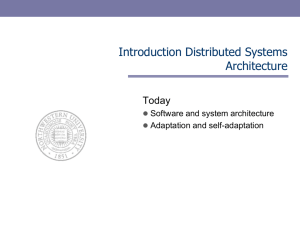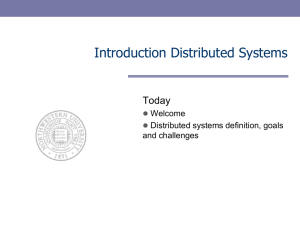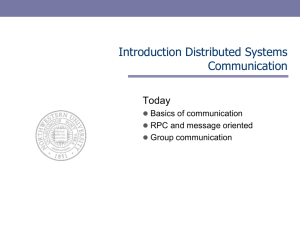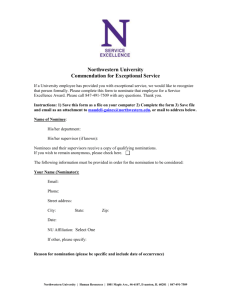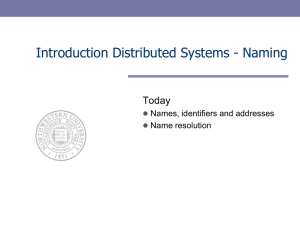Welcome to Distributed Systems
advertisement
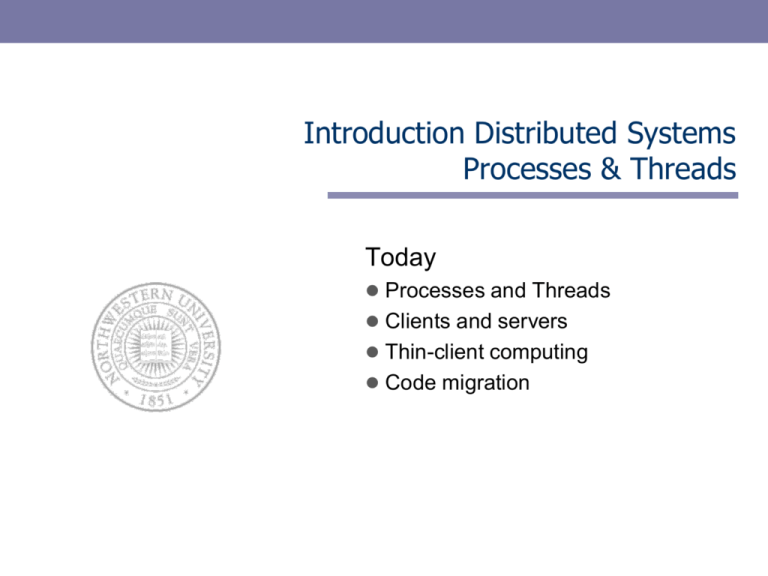
Introduction Distributed Systems Processes & Threads Today Processes and Threads Clients and servers Thin-client computing Code migration Processes and threads Distributed system – A collection of independent, interconnected processors … Processes – virtual processors, offer concurrency transparency, at a relatively high price on performance Threads offer concurrency w/ much less transparency – Applications with better performance that are harder to code/debug – Advantages of multithreading • • • • No need to block with every system call Easy to exploit available parallelism in multiprocessors Cheaper communication between components than with IPC Better fit for most complex applications – Alternative ways to provide threads • User-, kernel-level threads, LWP and scheduler activations MSIT Peer-to-Peer Computing Northwestern University 2 Threads in distributed systems – clients Client usage is mainly to hide network latency E.g. multithreaded web client: – Web browser scans an incoming HTML page, and finds that more files need to be fetched – Each file is fetched by a separate thread, each doing a (blocking) HTTP request – As files come in, the browser displays them Multiple request-response calls to other machines: – A client does several RPC calls at the same time, each one by a different thread – It then waits until all results have been returned – Note: if calls are to different servers, we may have a linear speed-up compared to doing calls one after the other MSIT Peer-to-Peer Computing Northwestern University 3 Threads in distributed systems – servers In servers, the main issue is improved performance and better structure Improve performance: – Starting a thread to handle an incoming request is much cheaper than starting a new process – Having a single-threaded server prohibits simply scaling the server to a multiprocessor system – As with clients: hide network latency by reacting to next request while previous one is being replied Better structure: – Most servers have high I/O demands. Using simple, wellunderstood blocking calls simplifies the overall structure. – Multithreaded programs tend to be smaller and easier to understand due to simplified flow of control MSIT Peer-to-Peer Computing Northwestern University 4 Server design Server – a process that waits for incoming service requests at a specific transport address Iterative vs. concurrent servers: Iterative servers can handle only one client at a time, in contrast to concurrent servers In practice, there is a 1-to-1 mapping between port and service, e.g. ftp: 21, smtp:25 Superservers: Servers that listen to several ports, i.e., provide several independent services; start a new process to handle new requests (UNIX inetd/xinetd) – For services with more permanent traffic get a dedicated server MSIT Peer-to-Peer Computing Northwestern University 5 Out-of-band communication How to interrupt a server once it has accepted (or is in the process of accepting) a service request? Solution 1: Use a separate port for urgent data (possibly per service request): – Server has a separate thread (or process) waiting for incoming urgent messages – When urgent msg comes in, associated request is put on hold • Require OS supports high-priority scheduling of specific threads or processes Solution 2: Use out-of-band communication facilities of the transport layer: – E.g. TCP allows to send urgent msgs in the same connection – Urgent msgs can be caught using OS signaling techniques MSIT Peer-to-Peer Computing Northwestern University 6 Servers and state Stateless servers: Never keep accurate information about the status of a client after having handled a request: – Don’t record whether a file has been opened (simply close it again after access) – Don’t promise to invalidate a client’s cache – Don’t keep track of your clients Consequences: – Clients and servers are completely independent – State inconsistencies due to client or server crashes are reduced – Possible loss of performance because, e.g., a server cannot anticipate client behavior (think of prefetching file blocks) MSIT Peer-to-Peer Computing Northwestern University 7 Servers and state Stateful servers: Keeps track of the status of its clients: – Record that a file has been opened, so that pre-fetching can be done – Knows which data a client has cached, and allows clients to keep local copies of shared data Observation: The performance of stateful servers can be extremely high, provided clients are allowed to keep local copies. As it turns out, reliability is not a major problem. MSIT Peer-to-Peer Computing Northwestern University 8 Thin-client computing Thin-client – Client and server communicate over a network using a remote display control • Client sends user input, server returns screen updates – Graphical display can be virtualized and served to a client – Application logic is executed on the server Technology enablers – Improvements in network bandwidth, cost and ubiquity – High total cost of ownership for desktop computing Big business opportunity – Sun Microsystems, Google, Microsoft, AT&T Virtual Network Computing, … MSIT Peer-to-Peer Computing Northwestern University 9 Code migration Instead of passing data around, why not moving code? What for? – Improve load distribution in compute-intensive systems – Save network resource and response time by moving processing data closer to where the data is – Improve parallelism w/o code complexities • Mobile agents for web searches – Dynamic configuration of distributed systems • Instantiation of distributed system on dynamically available resources; binding to service-specific, client-side code at invocation time MSIT Peer-to-Peer Computing Northwestern University 10 Models for code migration Process seen as composed of three segments – Code segment – set of instructions that make up the program – Resource segment – references to external resources needed – Execution segment – state of the process (e.g. stack, PC, …) Some alternatives – Weak/strong mobility – code or code and execution segments – Sender or receiver initiated – A new process for the migration code? – Cloning instead of migration MSIT Peer-to-Peer Computing Northwestern University 11 Question 3 What drives the market for application service providers? What would be the main factor limiting wide-area thin-client performance? MSIT Peer-to-Peer Computing Northwestern University 12 13
